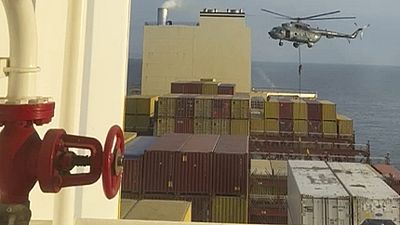(Reuters) - Following are five big themes likely to dominate thinking of investors and traders in the coming week and the Reuters stories related to them.
A SEASON OF THANKS AND HOPE
As 2018 inches towards close, many investors, such as those sitting on 16-percent losses on emerging market stocks, will be looking forward to turning the page on the year. Ditto for those who bought Italian bonds and found themselves 12 percent in the red. Buyers of U.S. equities, on the other hand, with 6 percent-plus returns, will have something to be grateful for at Thanksgiving.
As for 2019, where exactly should the canny fund manager go? Some clarity may emerge in coming days as investors start to detail investment bets for the year ahead, including at Reuters' annual asset allocation summit which runs all week in London, New York and Singapore. More than 30 hedge fund managers, stock and bond investors, short sellers and macroeconomists managing tens of trillions of dollars will lay out their vision for 2019.
We hasten to add that the events of 2018 wrong-footed some summit attendees from last year, not least on emerging markets and Italy. Others correctly called a Turkish crisis and stuck to holding U.S. tech, despite pricey valuations.
The summit coincides with a tricky investment landscape - will equities remain the go-to sector as the sugar-rush of President Donald Trump's $1.5 trillion stimulus starts to wear off? Will European growth and profits buck up? Tech - this year's "most crowded" trade - shows signs of exhaustion. As for China? Anyone's guess.
Watch this space.
(For a graphic on 'Global asset market performance' click https://tmsnrt.rs/2QvXlNE)
THE PRICE OF EVERYTHING
It's become pretty much evident, stateside, that the script has been torn up on all things White House-related. Midterm elections, at least, delivered the expected outcome - and despite President Trump's proclivity to credit Republican policies for the equity boom, investors seem to have cheered Democrats' winning the "House". A sign maybe that more stimulus is not necessarily what markets want for an economy growing at 3.5 percent - above the 2 percent rate considered its trend level.
Unsurprisingly, the Fed is keeping a steady course for a December rate rise. Another two moves are likely next year. But could that become three? Data on Wednesday may show. October inflation is expected at 2.4 percent (2.3 percent in September) but labour markets are tightening - average hourly wage inflation of 3.1 percent is the highest since 2009; some sectors report 5-10 percent wage growth.
The Fed question brings up the other issue - what does Trump do next? Deprived of a midterm win, starting his re-election bid and irked by the dollar's rise, he might ramp up his attacks on Fed policy. Also, expect rhetoric on migration. And of course on trade where China can safely expect to be in line for more flak.
(For a graphic on 'U.S. Consumer Price Index and Wage Inflation' click https://tmsnrt.rs/2Qqdh3X)
CHINA IN YOUR HANDS
Speaking of China, Trump's trade tantrums and Beijing's own credit clampdown are clearly cooling growth there. Probably more than Chinese authorities had expected. Factory inflation slowed in October for the fourth month and the car market, the world's largest, may be heading for an annual contraction, its first since at least 1990. Beijing therefore looks certain to unveil some stimulus, weakening the yuan further - and provoking even more ire from Trump.
Retail sales and industrial data ahead may show if existing measures have had any impact. However, each bout of weak data raises more stimulus exceptions, keeping the pressure on the yuan - the currency just had its worst week since July and is down 6.5 percent year-to-date. Beijing will be hoping to plot some kind of middle course to take pressure off President Xi Jinping when he comes face-to-face with Trump at a G20 summit later in November.
(For a graphic on 'Chinese GDP contributions' click https://tmsnrt.rs/2Pj4DHZ)
ROME AND BRUSSELS: A GRAND COLLISION
Italy has until Tuesday to submit a new draft budget to Brussels. EU rules require it to revise its 2019 structural deficit, so that it falls by 0.6 percent of GDP versus this year, rather than rise by 0.8 percent as planned now.
But the coalition in Rome, having won power on back of some generous election promises, is digging in its heels. Expectations of a collision with the EU is stressing its bond and stock markets, with Italy's 10-year bond yield premium over Germany staying stubbornly near the 300 basis-point mark that indicates financial strain.
But there's another layer of worry for markets - signs of tension within the coalition itself. A recent confidence vote in the government passed easily, but differences on policy are raising the prospect of fresh elections.
So far, markets and politicians have taken heart from S&P's recent decision not to downgrade Italy's credit rating. Talk of a fresh round of cheap ECB bank loans has helped too. Both factors have helped the Italy-Germany yield gap to hold below 300 bps. The question now is how long can that last in the face of the budget standoff?
(For a graphic on 'Italy's 10-year bond yield gap with Germany' click https://tmsnrt.rs/2QACngM)
THUMBS UP STERLING?
Brexit is nearing and the pound is getting twitchy. A mere "thumbs up" flashed by Brexit Secretary Dominic Raab at a BBC reporter after a cabinet meeting on Tuesday was enough to send sterling to that day's high of nearly $1.31 <GBP=D3>.
Growing expectations of a divorce deal by end-November between Britain and the EU have lifted sterling for two straight weeks. And because of a large number of short sterling positions held in options markets, the currency has tended to rise more sharply on signs of a breakthrough than it falls when talks reach impasse.
But there is still fear there's not enough progress on key sticking points - especially the Irish border - to hold an emergency EU summit later in November to sign off a deal. And any mooted deal is sure to face opposition in parliament and within Prime Minister Theresa May's Conservative party.
One sign of nerves is that sterling-dollar risk-reversals <GBP1MRR=>, a ratio of puts to calls on the currency and a barometer of investor bearishness, are near two-year highs. So at the upcoming cabinet meeting, May will be hoping her ministers give the nod - or a thumbs-up - to her Brexit negotiating position.
(For a graphic on 'Sterling valuations and positions' click https://tmsnrt.rs/2Pixqww)
(This version of the story has been refiled to fix typos)
(Reporting by Daniel Bases in New York, Marius Zaharia in Hong Kong; Sujata Rao, Dhara Ranasinghe and Tom Finn in London; compiled by Sujata Rao; edited by Andrew Heavens)



